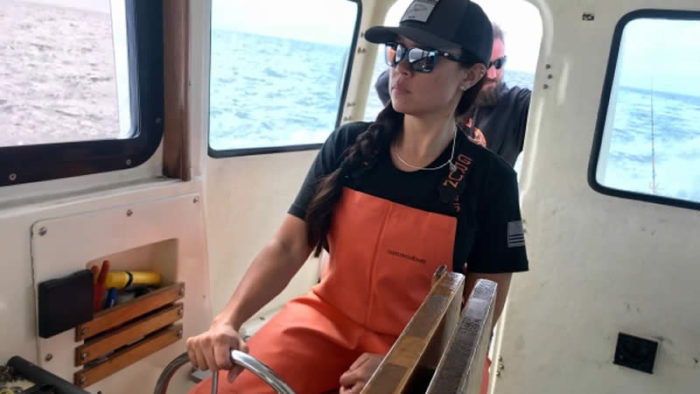When fashion says, “go fish,” consumers head to the outdoors with bait and tackle — and sporty, sensible style.
It all began in 2020 when the coronavirus pandemic confined consumers to their homes, and nature was one of the only safe and simple escapes that remained readily accessible. Outdoor apparel and equipment retailer L.L. Bean said its fishing category rose 4 percent last year when compared to 2019, with spin fishing outfits for “Rod & Reel” combos climbing up a startling 120 percent.
Its ice fishing segment also increased by 20 percent, and for the 2020 fly fishing season, which spans from May through September, the category saw a 60 percent uptick compared to 2019, all according to L.L. Bean.
Charlie Bruder, vice president of merchandising at L.L. Bean, told WWD that the recreational fishing industry was already booming prior to the pandemic — but the year at home inspired new entrants to the sport.
“Americans connected with the outdoors in record numbers in 2020, and the fishing category saw significant growth among both experienced anglers finding more time to get on the water and beginners seeking new ways to spend time outside. In fact, according to the Outdoor Industry Association, freshwater fishing added 3.4 million participants in 2020.”
Interestingly, those new participants include younger generations — and women. “Fishing has seen significant growth as many are trying it for the first time. This is in large part due to the fact that fishing is a great way to connect with the outdoors yet has a lower barrier to entry than other outdoor pursuits, from skill to cost to accessibility.”
“Given the stresses of 2020, we believe many people discovered how that connection and time outside made them simply feel better — and early 2021 indications show that interest in the outdoors is only going to continue.”
Ash Williams, vice president of marketing at Grundéns, a performance fishing apparel company, told WWD that the gender gap has been closing in recent years, with 46 percent of anglers being female. “Among girls, ages 13 to 17, participation grew by 6 percent, which was the most growth in any female age group. COVID-19 has in part accelerated this growth in female participation. Brands have woken up to this opportunity and producing women’s-specific products, such as our Women’s Deck-Boss ankle boots and Petrus Jacket and Bibs.”
Fashion-forward fisher people are focused on finding new threads, and footwear. “We’re also seeing strong sell-through of our apparel products that are specifically designed for sport anglers and our launches into the footwear market has also been very successful with the recent introduction of our SeaKnit Boat Shoe, designed from the deck up.”
And like any sport, when it comes to fashion, utilitarianism is the leading philosophy. “Sport anglers are increasingly looking for performance products that are waterproof, breathable, lightweight, and enhance the fishing experience. Gone are the days of bulky, non-breathable outerwear that restrict freedom of movement,” Williams added.
With more than 45 million sport anglers in the U.S. alone, fishing is the nation’s second most popular outdoor activity after jogging, according to Williams. “The economic benefit of fishing is massive, over $50 billion in annual retail sales. As an activity, you can do while social distancing, COVID-19 has motivated people to reengage or start fishing for the first time with a sharp increase in fishing license purchases. There’s an environmental benefit to these license sales as a portion of license revenues goes towards water and fishery conservation programs.”
Williams said 90 percent of current anglers start fishing in their childhood and are introduced by an older family member. “The importance of introducing fishing to younger demographics is crucial for the industry. This has been true for a number of years but with an overall increase in participation, the passion for fishing is being passed down to more and more young people. A trend that we’re all happy to see and is essential to the long-term health of the industry.”
Swimming Against the Current
Like most brands and retailers, the pandemic forced strategic pivots — but for some, it was more about seizing an unusual and unexpected opportunity to connect with consumers in new and interesting ways. Simon Perkins, president of outdoor apparel and fly fishing gear retailer Orvis, told WWD, “The pandemic has moved more people to turn to the outdoor world for their health, well-being and inspiration. It presented the opportunity to try something new, and for many, that’s been fly fishing. For Orvis, this meant pivoting our approach to welcoming new anglers to the sport given we couldn’t engage in person as much as we typically do.”
That means Orvis sought to “fully leverage” its strong collection of online resources it had been building for years, which included its Orvis News blog, the Orvis Fly Fishing Learning Center, and its Fly Fishing Guide Podcast.
“We also needed to innovate and add new virtual resources to help us find new ways to connect with our customers. Since we knew our in-person courses and instructions would be impacted, we created and launched Virtual Casting Instruction and turned our retail Fly Fishing 101 courses into a digital series. We have also been hosting weekly Facebook and Instagram live events where anglers of all levels can come together online and learn from members of our fishing team,” Perkins said.
Orvis agreed with its contemporaries that new entrants to the sport are a welcome change. “It feels like the outdoors is as important to people right now as it ever has been. Additionally, the fishing industry has been doing more to welcome women, younger generations and more diverse communities into the sport. The combination is having a meaningful impact.”

A recent study by the Recreational Boating and Fishing Foundation found that recreational fishing has reached new milestones in diversity and inclusivity, including an all-time high of 18 million women participating in the sport, Perkins told WWD. “Working to make fly fishing accessible and understanding how we can continue to break down barriers to entry has always been important to us. We started our schools over 50 years ago, offer free fly fishing 101 classes in our retail stores, and have built a robust library of online resources that can support newcomers to the sport.
“We are extremely passionate about fly fishing, but when you are passionate about something, you can be so close to it that you have blind spots, so we must always be curious and listen to find opportunities.”
It’s how the brand’s 5050 on the Water campaign, a program focused on creating gender parity in fly fishing, began several years ago, “when it became clear to us that there was a big opportunity to inspire and celebrate women in the sport of fly fishing,” Perkins said. “We prioritized women-specific gear development and education and adventure trips focused on creating community and welcoming environments for new anglers. Additionally, many local guides and Orvis endorsed outfitters host similar events.”
All this led to Orvis examining the trends it had been seeing in its markedly increased engagement. “In 2020, our fishing business was up 17 percent over 2019, which included notable growth in our entry-level product sales. States around the country have reported significant increases in fishing license sales, and we are seeing record-setting interest in our adventure trips for 2021. This is great for our local independent dealers, guides, outfitters, lodges — and the industry as a whole after a challenging 2020.”


